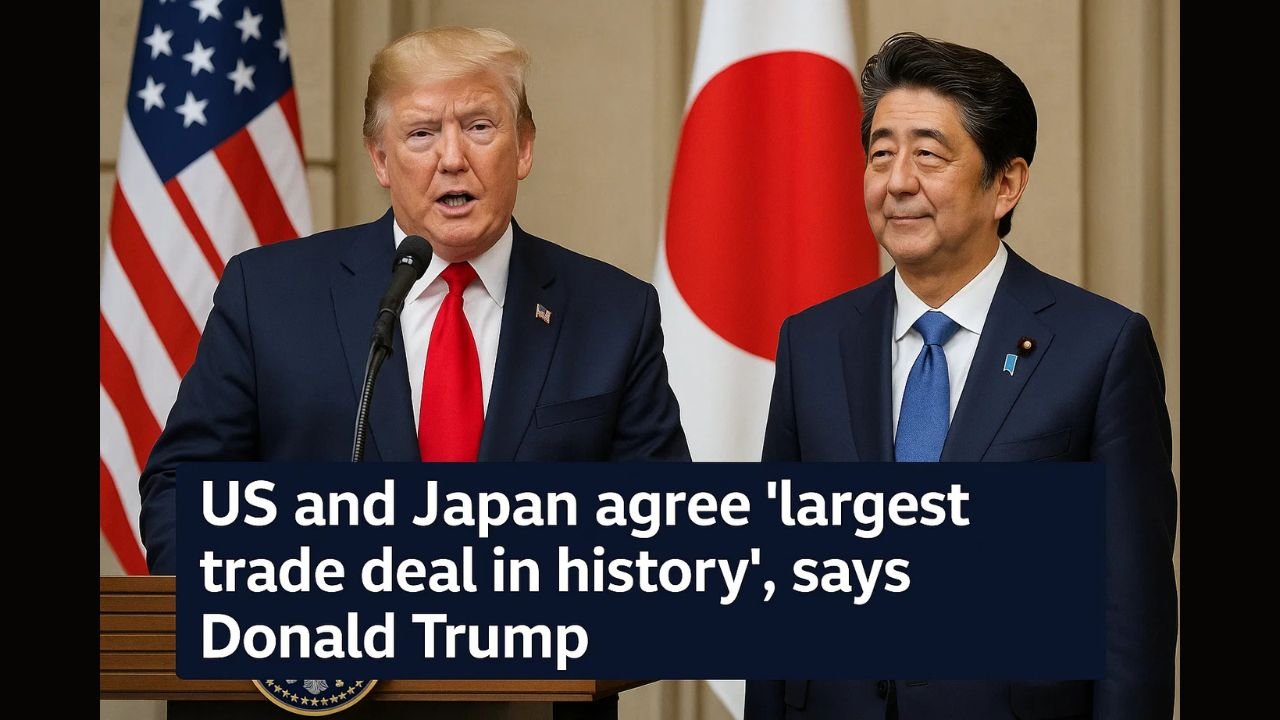The recently announced US-Japan trade agreement by the Trump administration has triggered intense discussions across global financial media. The deal includes a 15% tariff framework and promises an astounding $550 billion in Japanese investments over the next decade. But what exactly does this mean for the American economy, the U.S. workforce, and the global trade landscape?
Let’s dive deep into the terms of the deal, its implications, and the political and economic strategies behind this historic trade pact.
What Is the New US-Japan Trade Deal?
On July 22, 2025, former President Donald Trump, widely regarded for his aggressive trade diplomacy during his earlier term, signed a new trade agreement with Japanese Prime Minister Fumio Kishida. The deal aims to strengthen economic cooperation between the two countries while ensuring American manufacturing and technology interests are protected.
Key components of the deal include:
- 15% flat tariff on selected Japanese goods entering the U.S., including electronics, automobiles, and steel.
- In return, Japan has committed $550 billion in foreign direct investment (FDI) in U.S. infrastructure, semiconductor manufacturing, and green energy over the next 10 years.
- New clauses on AI regulation, technology exchange, and cybersecurity cooperation.
- Japanese companies granted smoother access to American agricultural markets.
How the Deal Affects the U.S. Economy
1. Boost to American Jobs
One of the most touted benefits of this deal is job creation. With $550 billion in Japanese investment, several sectors—particularly semiconductor fabs, EV battery production, AI R&D centers, and smart manufacturing hubs—will see rapid growth.
🔹 States like Texas, Michigan, Ohio, and Arizona are already being eyed as potential sites for new Japanese-funded industrial parks.
🔹 Estimates from the U.S. Department of Commerce suggest this could create over 750,000 jobs within the next five years.
2. Strengthening the U.S. Tech and Manufacturing Sectors
This deal is a strategic step toward reducing American dependence on Chinese manufacturing. Japan’s involvement in setting up tech centers in the U.S. supports the Biden-era CHIPS Act and enhances U.S. dominance in semiconductors, robotics, and green tech.
🔹 Expect major players like Sony, Toyota, Hitachi, and Mitsubishi to open or expand operations in the U.S.
🔹 Experts believe this could increase U.S. tech exports to the Asia-Pacific region by 30% in the next three years.
What Does the 15% Tariff Mean for Japanese Companies?
While the investment side of the deal is a win-win, the 15% import tariff places pressure on Japanese exporters, especially automakers. However, the deal includes special exemptions and fast-track policies for companies that relocate production to the U.S., essentially encouraging onshoring.
🔹 This will shift Japanese brands like Toyota, Honda, and Nissan to build more vehicles directly in the United States, improving local job markets.
Geopolitical Implications
This trade agreement isn’t just about economics—it’s a geostrategic signal.
- Countering China: With tensions in the South China Sea and Taiwan Strait, a strong U.S.-Japan economic axis limits Chinese influence.
- Rebalancing the Indo-Pacific: This deal may influence other regional powers like India, South Korea, and Australia to align economically with the U.S.
🔹 Japan’s investments also support U.S. military infrastructure, with a portion going to defense tech and satellite collaboration.
Impact on American Workers and Labor Policy
While new jobs are expected, there’s also a growing conversation around labor rights, wage standards, and union participation. The deal mandates that Japanese firms operating in the U.S. must follow American labor laws, which ensures:
- Competitive wages
- Worker protections
- Opportunities for local employment, especially in Rust Belt states
Unions, including the United Auto Workers (UAW) and AFL-CIO, have welcomed the move, calling it a “step toward fair global capitalism.”
Economic Forecast: A Win or a Gamble?
Economists are cautiously optimistic.
- The $550 billion investment could raise U.S. GDP by 1.2% over five years.
- However, the tariff element may trigger retaliatory measures from other trading partners.
- The stock markets responded positively—with tech, infrastructure, and green energy stocks rising immediately after the announcement.
Still, critics argue that without proper oversight, Japanese firms could use tax havens or labor loopholes. Others worry about inflationary effects on consumer goods due to tariffs.
Political Reactions in the U.S.
Trump Supporters:
They hail the deal as another example of “America First” economics, prioritizing local jobs, innovation, and trade balance.
Democrats:
Some Democrats are cautiously supporting the investment component but call for stronger environmental and labor protections.
Independents & Analysts:
They see the agreement as a sign that Trump may be preparing for a stronger 2026 political comeback—with foreign policy and economic wins under his belt.
Conclusion: A New Chapter in U.S.-Japan Relations
This trade deal is more than just numbers—it’s a strategic, economic, and political milestone. If implemented properly, it has the potential to reshape America’s industrial base, reduce dependence on Chinese goods, and strengthen alliances in Asia.
But the real test lies in execution—will Japanese companies follow through, will American workers benefit, and can this deal stand the test of global trade dynamics?
Only time will tell.
US and Japan agree ‘largest trade deal in history’, says Donald Trump | BBC News
